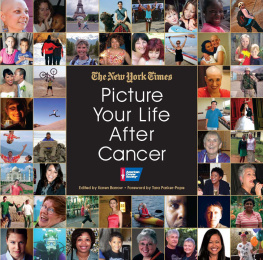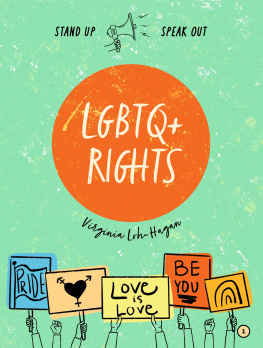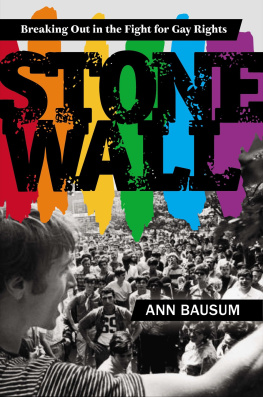
The Stonewall Inn on Christopher Street in New
York City is just another barjust another gay
barwith the
thump-thump-thump
of dance music,
and people, men mostly, clustered around the bar,
glancing at their phones, checking out the crowd,
or trying to get a bartenders attention. Some are
dancing and others are slipping out to the street
for a smoke, no matter how cold it is.
But this bar in Greenwich Village has been more
than that for half a centuryit is a shrine. Walk
by any day or night, particularly on Pride week-
end in June, and the sidewalk is clumped with
people posing for photographs next to the neon
Stonewall Inn sign in the window, or in front of
its New York State historical landmark plaque.
Madonna showed up there one New Years Eve.
It has become the symbol of the modern gay rights
movement because of something that happened
there fifty years ago in June.
The Stonewall of that era was far different than
it is today. It was a dive, with overpriced, watered-
down drinks and ties to the mob, and a target for
busts and shakedowns by the police. What hap-
pened on the night of June 28, 1969, has been
mythologized and, yes, exaggerated over the years.
In the late 1990s I cowrote a book on the movement
with Dudley Clendinen, and it seemed like every
New York gay and lesbian old-timer we spoke to
claimed to have been there that night. But the fact
is that the police did raid the place, and patrons,
including the drag queens who were an integral part
of the Stonewall clientele, fought back.
Within days, a group of activistsmany already
beginning to be radicalized by the churn of the
late 1960s: the antiVietnam War demonstrations,
the civil rights struggle, and the feminist move-
mentgathered in a loft to form the Gay Liber-
ation Front. And yes, a movement was bornor
at least a neat moment presented itself to define
the next chapter of a civil rights struggle that had
been lumbering along, mostly out of sight, in the
form of organizations like the Daughters of Bilitis
and the Mattachine Society. Within the next two
years, pride marches were drawing thousands of
attendeesand onlookers, including newspaper
reporters and television crewsfrom Manhattan
to Los Angeles. Those marches continue to this day.
Standing in front of the Stonewall Inn now, its
almost impossible to comprehend the sweep of
change, progress, and tragedy of the past fifty
years. Weve lived to see a revolution in our own
time, Arthur Evans, who sprang to activism after
the uprising, helping to create New Yorks Gay
Activists Alliance, told me in his kitchen in San Fran-
cisco several years ago. If things had been this way
in 1969, I never would have become a noisy street
activist. Instead, I would be a quiet professor leading
an unobtrusive life in a small university.
And what a revolution it has been. The notion
that the United States Supreme Court might one
day affirm the constitutional right of same-sex mar
-
riage would have seemed unthinkable to those early
pioneers, if they had thought about it at all; most
did not. Gay people have moved from the shadows
to positions of stature and influence across Amer-
ican life: television hosts and Hollywood movie
stars; news anchors and city council presidents;
governors and corporate executives.
When Jerry Brown, the former governor of Cali-
fornia, appeared before a gay audience in Wash-
ington, D.C., when he ran for president in 1979
with reporters and camera crews gathered in the
backit was a moment in history. Now, it is hard to
imagine a Democratic candidate for president win-
ning the party nomination without a total embrace
of gay rights. That may not yet be the case for most
Republicans, but even a casual perusal of polling
dataon the views of same-sex marriage and gay
rights among younger Americansleaves little
doubt that Republican candidates will move to the
Introduction
BY ADAM NAGOURNEY

same ground soon enough, if only in the interest of
political survival. The AIDS epidemicfor all the
unthinkable destruction, death, and heartbreak it
spread across the nationproduced a movement
that was more sophisticated in the ways of gov-
ernment, medicine, and public advocacy. Recall
the era-defining manifesto of ACT UP, the AIDS
organization: Silence = Death. Before Stonewall,
many of the older activists were chided for being
too polite and passive. Now the AIDS movement,
and the gay rights movement, had become loud,
demanding, insistent, and very public.
From the beginning, this has been a movement of
fits and starts, of triumphs and disappointments. And
to pronounce the gay rights movement a success
a battle won and donewould be a vast over-
statement, as the election of 2016 made clear. The
advances have taken place mostly in urban areas
and on the coasts; pockets of anti-gay sentiments
exist in many corners of the country. Two women


























